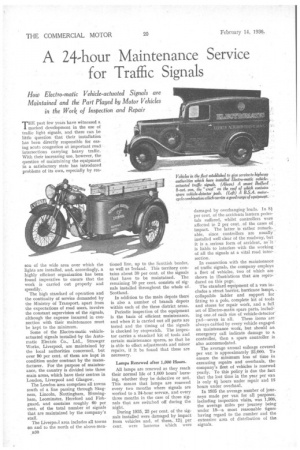A 24-hour Maintenance Service for Traffic Signals
Page 40

If you've noticed an error in this article please click here to report it so we can fix it.
How Electro-rnatic Vehkle-actuated Signals are Maintained and the Part Played by Motor Vehicles in the Work of Inspection and Repair
THE past few years have witnessed a marked development in the use of traffic light signals, and there can be little question that their installation has been directly responsible for easing acut..• congestion at important road intersections carrying heavy traffic. With their increasing use, however, the question of maintaining the equipment in a satisfactory state has introduced problems of its own, especially by rea
son of the wide area over which the lights are installed, and, accordingly, a highly efficient organization has been found imperative to ensure that the work is carried out properly and speedily.
The high standard of operation and the continuity of service demanded by the Ministry of Transport, apart from the expectations of road users, involve the constant supervision of the signals, although the expense incurred in connection with their maintenance must be kept to the minimum.
Some of the Electro-matic vehicleactuated signals installed by the Automatic Electric Co., Ltd., Strowger Works, Liverpool, are maintained, by the local authorities concerned, but over 90 per cent, of them are kept in condition under contract by the manufacturer. For the purpose of maintenance, the country is divided into three main areas, which have their centres in London, Liverpool and Glasgow.
The London area comprises all towns south of a line passing through Skegness, Lincoln, Nottingham, Birmingham, Leominster, Hereford and Fishguard, and contains roughly 60 per cent, of the total number of signals that are maintained by the company's staff.
The Liverpool area includes all towns on and to the north of the above-men,B30 tioned line, up to the Scottish border, as well as Ireland. This territory contains about 30 per cent, of the signals that have to be maintained. The remaining 10 per cent. consists of signals installed throughout the whole of . Scotland.
In addition to the main depots there is also a number of branch depots within each of the three district areas.
Periodic inspection of the equipment is the basis of efficient maintenance, and when it is carried out all parts are tested and the timing of the signals is checked by stopwatch. The inspector carries a standard kit of tools and certain maintenance spares, so that he is able to effect adjustments and minor repairs, if it be fousid that these are necessary.
Lamps Renewed after 1,000 Hours.
All lamps are renewed as they reach their normal life of 1,000 hours' burning, whether they be defective or not. This means that lamps are renewed every two months where signals are worked to a 24-hour service, and every three months in the case of those signals that are switched off during the night.
During 1935, 23 per cent. of the signals installed were damaged by impact from vehicles and, of these, 121 per cent, were lanterns which were damaged by overhanging • loads. In 81 per cent, of the accidents lantern pedestals suffered, whilst controllers were affected in 2 per cent. of the cases of impact. The latter is rather remarkable, since controllers are usually installed well clear of the roadway, but it is a serious form of accident, as it is liable to interfere with the working of all the signals at a vital road intersection.
In connection with the maintenance of traffic signals, the company employs a fleet of vehicles, two of which are shown in illustrations that are reproduced on this page.
The standard equipment of a van includes a street barrier, hurricane lamps, . collapsible ladder and support for fitting to a pole, complete kit of tools and stores for repair work, and a full set of Electro-matk spare parts, includ2 ing one,of each size of vehicle-detector
pad—seven in all. These items are always carried by every vehicle engaged on maintenance work, but should an emergency call indicate damage to a controller, then a spare controller is also accommodated.
The average annual mileage covered per var. is approximately 23,000. To ensure the minimum loss of time iu executing repairs and overhauls, the company's fleet of vehicles is renewed yearly. To this policy is due the fact that the lost time in the year per van is only 41 hours under repair and 15 hours under overhaul.
In 1935 the average number of journeys made per van for all purposes, including inspection visits, was 1,308, the average miles per journey being under 18—a meat reasonable figure having regard to the number and the extensive area of •distribution of the signals.




















































































